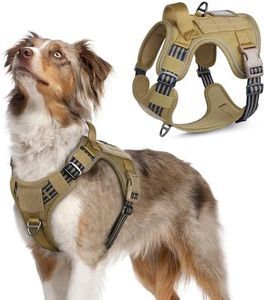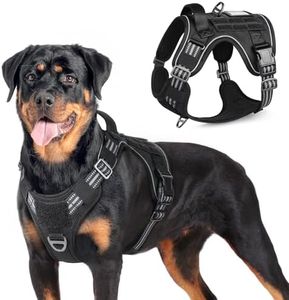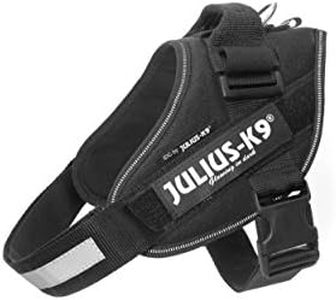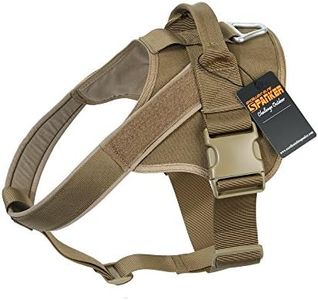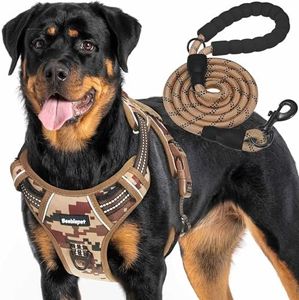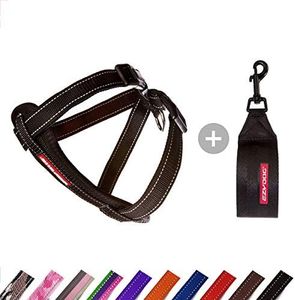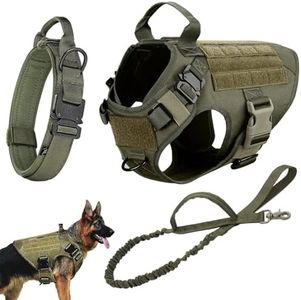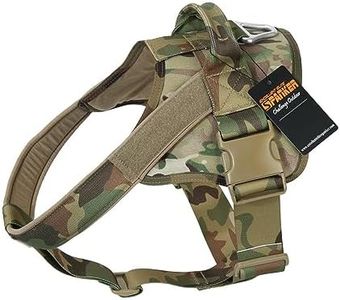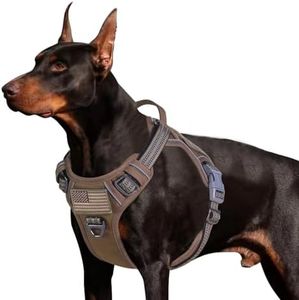We Use CookiesWe use cookies to enhance the security, performance,
functionality and for analytical and promotional activities. By continuing to browse this site you
are agreeing to our privacy policy
10 Best Tactical Dog Harnesses
From leading brands and best sellers available on the web.Buying Guide for the Best Tactical Dog Harnesses
Choosing a tactical dog harness is about finding the right balance between durability, control, comfort for your dog, and your intended use. Whether you need it for everyday walks, outdoor adventures, training, or working scenarios like service or police work, it's important to pay attention to the features and construction of the harness. Think about your dog's size, strength, activity level, and temperament, as well as how you plan to use the harness most often.Material and DurabilityMaterial refers to what the harness is made of, such as nylon, polyester, or similar tough fabrics. Durability matters because tactical harnesses are often used in rough environments and need to withstand pulling, weather, and sometimes chewing. Some harnesses have reinforced stitching and heavy-duty buckles. If you need the harness for demanding situations like hiking or working dogs, look for thick, rugged materials. For light daily use, a lighter build may suffice. Choose based on how intense your dog's activity will be and if you expect the harness to face a lot of wear and tear.
Attachment Points and Leash ClipsAttachment points are the rings or loops where you connect the leash. Sometimes there is one on the back, one on the chest, or even extra points for training tools or accessories. Back clips are good for regular walks and less pulling, while front clips help reduce pulling by giving you more control. If you need flexibility or want to attach equipment, look for multiple points. Decide what walking or training style you prefer, and if your dog pulls, consider a harness with a front clip.
Fit and AdjustabilityFit refers to how well the harness sits on your dog’s body, while adjustability is about how much you can change the harness size with straps and buckles. Good fit prevents chafing, escaping, and discomfort. Harnesses come in sizes, but adjustable straps help you fine-tune for your dog’s build. Most dogs need a snug-but-not-tight fit. If your dog is between sizes or still growing, adjustability is extra important. Measure your dog carefully, and consider harnesses with more points of adjustment for a custom fit.
Padding and ComfortPadding is extra cushioning in areas like the chest, belly, and back to prevent rubbing and make the harness more comfortable for your dog, especially during long activities or strong pulls. If your dog has sensitive skin or will wear the harness for long periods, look for one with thick, soft padding. If comfort is less of an issue or for quick walks, minimal padding is lighter and cooler. Think about your dog’s coat type, skin sensitivity, and typical activity duration.
MOLLE or Attachment SystemsMOLLE (Modular Lightweight Load-carrying Equipment) or similar systems are loops or rails stitched onto the harness where you can attach pouches, badges, or gear. This is useful if your dog will carry supplies on hikes or needs to display ID for service or therapy work. If you need your dog to carry anything, pick a harness with MOLLE. For casual walkers, this is less important and can add unnecessary weight.
Handles and Control FeaturesHandles are built-in grips on the top of the harness that let you quickly and securely hold or lift your dog. They're especially helpful for dogs in training, dogs that need assistance, or in situations where fast control is needed. Larger and active dogs benefit more from sturdy handles. If you expect to help your dog over obstacles, lift them, or need close control, look for a harness with a strong, comfortable handle.
Visibility and IdentificationVisibility features include reflective strips, bright colors, or areas for attaching ID patches. These help keep your dog noticeable in low light or signal your dog’s role, like service or therapy. For early morning or night outings, or for working dogs, strong reflective elements are a big plus. If your outings are short and mostly in daylight, this matters less. Decide based on your dog’s environment and whether identification is important.

